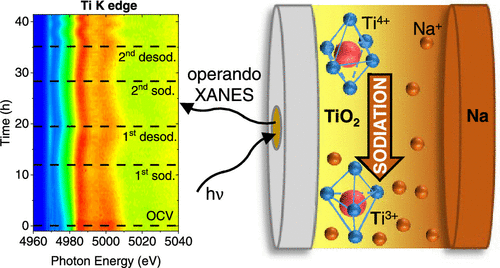当前位置:
X-MOL 学术
›
ACS Appl. Energy Mater.
›
论文详情
Our official English website, www.x-mol.net, welcomes your feedback! (Note: you will need to create a separate account there.)
Monitoring the Sodiation Mechanism of Anatase TiO2 Nanoparticle-Based Electrodes for Sodium-Ion Batteries by Operando XANES Measurements
ACS Applied Energy Materials ( IF 6.4 ) Pub Date : 2020-12-22 , DOI: 10.1021/acsaem.0c02025 Andreas Siebert 1 , Xinwei Dou 2, 3 , Raul Garcia-Diez 1 , Daniel Buchholz 2, 3 , Roberto Félix 1 , Evelyn Handick 1 , Giorgia Greco 4 , Ivana Hasa 2, 3 , Regan G. Wilks 1, 5 , Stefano Passerini 2, 3 , Marcus Bär 1, 5, 6, 7
ACS Applied Energy Materials ( IF 6.4 ) Pub Date : 2020-12-22 , DOI: 10.1021/acsaem.0c02025 Andreas Siebert 1 , Xinwei Dou 2, 3 , Raul Garcia-Diez 1 , Daniel Buchholz 2, 3 , Roberto Félix 1 , Evelyn Handick 1 , Giorgia Greco 4 , Ivana Hasa 2, 3 , Regan G. Wilks 1, 5 , Stefano Passerini 2, 3 , Marcus Bär 1, 5, 6, 7
Affiliation

|
Anatase TiO2 represents an attractive electrode material for application in sodium-ion batteries due to its relatively low cost, high environmental compatibility, high intrinsic safety, conferred by the relatively high operating voltage, and satisfactory theoretical capacity. Nonetheless, a comprehensive understanding of the Na uptake and release mechanism is still missing, which is crucial for further insight-driven optimization of the electrode material. This work presents for the first time an extensive operando X-ray absorption near-edge structure spectroscopy (XANES) study at the Ti K-edge of a TiO2 anatase nanoparticle-based electrode, aiming at unraveling the structural evolution and consequent Ti oxidation state and coordination changes upon sodiation and following desodiation. Using two approaches, i.e., an analytical fit and principal component analysis (PCA) with a linear combination analysis (LCA) for the evaluation of operando data, this study reveals the amount of irreversible and reversible Na+ inserted upon cycling. In addition, a change of Ti coordination during the first cycle is monitored, observing a decrease of the original six-coordinated symmetry. Simultaneously, the irreversible loss of the nanoparticle structural ordering due to the effect of initial Na insertion in the anatase lattice is detected. These results support some of the (ex situ) findings reported previously and give a more comprehensive picture of the highly discussed sodiation mechanism of TiO2-based anodes under more realistic operating conditions.
中文翻译:

通过Operando XANES测量监测基于锐钛矿TiO 2纳米粒子的钠离子电池电极的形成机理
锐钛矿型TiO 2由于其相对较低的成本,较高的环境相容性,较高的本质安全性,相对较高的工作电压和令人满意的理论容量,因此是用于钠离子电池的有吸引力的电极材料。但是,仍然缺少对Na吸收和释放机制的全面了解,这对于进一步洞察驱动电极材料的优化至关重要。这项工作首次展示了在TiO 2的Ti K边缘进行的广泛的操作X射线吸收近边缘结构光谱(XANES)研究。锐钛矿纳米粒子为基础的电极,旨在揭示结构演变以及随之而来的钛氧化态以及在成盐后和成色后的配位变化。使用两种方法,即分析拟合和主成分分析(PCA)与线性组合分析(LCA)来评估操作数据,这项研究揭示了循环中插入的不可逆和可逆Na +的量。另外,在第一循环期间监测Ti配位的变化,观察到原始的六配位对称性降低。同时,检测到由于初始Na插入锐钛矿晶格中的作用而导致的纳米颗粒结构有序的不可逆损失。这些结果支持了一些(的易地)先前报道的发现,并给出了在更现实的操作条件下经过高度讨论的TiO 2基阳极的增附机理的更全面的描述。
更新日期:2021-01-25
中文翻译:

通过Operando XANES测量监测基于锐钛矿TiO 2纳米粒子的钠离子电池电极的形成机理
锐钛矿型TiO 2由于其相对较低的成本,较高的环境相容性,较高的本质安全性,相对较高的工作电压和令人满意的理论容量,因此是用于钠离子电池的有吸引力的电极材料。但是,仍然缺少对Na吸收和释放机制的全面了解,这对于进一步洞察驱动电极材料的优化至关重要。这项工作首次展示了在TiO 2的Ti K边缘进行的广泛的操作X射线吸收近边缘结构光谱(XANES)研究。锐钛矿纳米粒子为基础的电极,旨在揭示结构演变以及随之而来的钛氧化态以及在成盐后和成色后的配位变化。使用两种方法,即分析拟合和主成分分析(PCA)与线性组合分析(LCA)来评估操作数据,这项研究揭示了循环中插入的不可逆和可逆Na +的量。另外,在第一循环期间监测Ti配位的变化,观察到原始的六配位对称性降低。同时,检测到由于初始Na插入锐钛矿晶格中的作用而导致的纳米颗粒结构有序的不可逆损失。这些结果支持了一些(的易地)先前报道的发现,并给出了在更现实的操作条件下经过高度讨论的TiO 2基阳极的增附机理的更全面的描述。



























 京公网安备 11010802027423号
京公网安备 11010802027423号